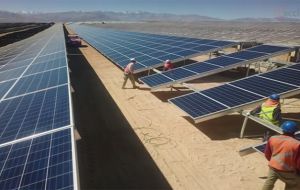MercoPress. South Atlantic News Agency
Chile connects Latin America's largest solar plant to the national grid
 The El Romero Solar plant in Chile features 776,000 photovoltaic modules.
The El Romero Solar plant in Chile features 776,000 photovoltaic modules. Spanish clean energy company Acciona Energía has connected the 246MW El Romero solar plant in Atacama desert, Chile to the county’s Interconnected Central System (SIC), becoming Latin America's largest. The US$343m El Romero Solar plant features 776,000 polycrystalline silicon photovoltaic modules, spread across 280ha area in the municipality of Vallenar, 645km north of the Santiago.
Acciona Energía Chile general manager José Ignacio Escobar said: “We completed the project in record time.
“We are committed to the objective of achieving a clean and sustainable energy mix in Chile, and the best way to demonstrate this is to complete the projects we undertake to the technical quality standards required and in the shortest possible timescale.”
In addition to reducing CO2 emission of approximately 485,000 tons per year, the plant is designed to generate 505GWh of clean energy per year meeting power needs of 245,000 Chilean homes.
The project is expected to contribute to the company's effort to supply 600GWh of renewable power to distribution concession holders in the Central Interconnected System (SIC) from 2018.
Acciona Energía said it will negotiate private purchase and sale contracts for the electricity produced in the other renewables projects currently under construction in Chile.
Recently, the firm won the rights to build Puerto Libertad photovoltaic complex in Sonora following a tender round in Mexico. The company is engaged in the development and management of infrastructure, renewable energy, water and services.




Top Comments
Disclaimer & comment rules-

-

-

Read all comments@Marti Llazo
Nov 15th, 2016 - 06:05 pm +6I wasn't proposing that Chile should generate large amounts of solar in Aisen. I was saying it is great that they are investing in the generating from solar in the north. Given that is where the demand is, it makes good sense to generate in the north.
Rather than make assumptions about what I may have observed, you should focus on your own observation skills, which appear lacking based on your post. Firstly, October is spring in that part of the world not summer. Secondly, your assertion that there is “no sunshine” in Aisen is hugely inaccurate. For a start, it was sunny everyday for the 3 weeks I was there. I also noticed quite a few dwellings with solar panels so there must be a reasonable amount of sunshine. Further, I noticed that the climate changes greatly from one valley to the next. In Puerto Tranquillo and Puerto Guadal there are cherry trees, apple, strawberries, black currents and other fruit that only flourish with a good amount of sunshine, and judging by the delicious home made jams served with breakfast, flourish they do. I appreciate that the existence of multiple micro-climates may overwhelm your evidently simplistic power of observation.
I remember from a previous story that you claimed Chilean air pollution was as bad as China's. You are prone to exaggerate some what. So to repeat what I posted then...
it is inaccurate to say that: ”(Chile has) Air quality as bad as China”.
The World Health Organisation data shows air pollution in China to be significantly worst than in Latin America. Santiago is less polluted than almost every city in China for which there are data.
Have a look at this site - real time air pollution monitoring:
https://waqi.info/
China is a mass of red flags. At time of posting the only red flags in South America: Lima, Sao Paulo and Bahia Blanca - none in Chile! Also interesting is that Chile seems to be measuring air pollution in every town, whereas other countries in the region have almost no monitoring.
“massive area of habitat”?!
Nov 14th, 2016 - 11:56 am +3And what inhabits this habitat?
We have massive empty desert areas, many of which are pristine and beautiful, but there is more than enough to support important projects like this.
How would you suggest we generate our electricity? Burn more coal? Ship more oil and gas in from across the ocean?
Funny how, while some continue debating whether climate change is caused by humans, technology continues to forge ahead and will sooner than later reduce our dependence on dirty, non-renewable energy sources.
Nov 14th, 2016 - 09:21 pm +3Commenting for this story is now closed.
If you have a Facebook account, become a fan and comment on our Facebook Page!